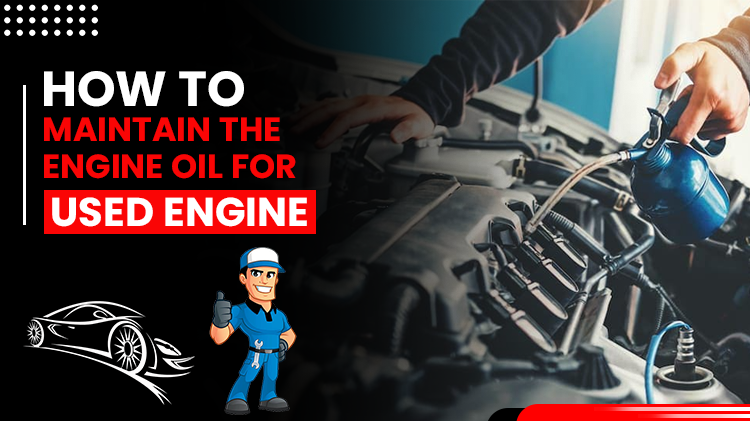The heart of your car, in the quick-paced world of automobiles, is the engine. It propels your adventures and makes getting from A to B . Maintaining the condition of your engine is essential whether you’re a seasoned auto enthusiast or just someone searching for dependable transportation. This is esd-follow advice to keep your engine roaring.
Understanding Engine Oil
Let’s start with the fundamentals before getting into the finer details of engine oil maintenance. Your engine’s performance and lifetime are greatly influenced by engine oil. It lubricates moving components, lessens friction, and aids in heat dissipation. Engine oil degrades over time, becoming less efficient and possibly damaging to your engine. Understanding the many types of engine oil and how to select the best one is crucial for ensuring that your used engine stays in excellent condition.
Types of Engine Oil
• Conventional Oil: Made from crude oil, conventional oil, also known as mineral oil, is the preferred choice. Although it may need to be changed more frequently than synthetic oils, it is appropriate for the majority of engines.
• Synthetic Oil: Designed for optimum performance, synthetic oil. It delivers increased fuel efficiency, longer intervals between replacements, and superior protection in harsh situations.
• Blend Oil: This choice creates a balance between performance and cost-effectiveness by combining conventional and synthetic oils.
Choosing the Right Engine Oil
Consult the owner’s manual for your car to find the best engine oil for a used engine. The recommended oil type and viscosity will be specified. Your choice may also be influenced by variables like the weather and your driving style. For used engines, synthetic oils are typically a good choice because they offer better protection and extend engine life.
Engine Oil Change Frequency
Now that you are familiar with the fundamentals of engine oil, let’s talk about how frequently you should replace it. Maintaining engine health requires changing your engine oil at the proper intervals.
Follow the Manufacturer’s Recommendations
The owner’s manual for your car contains recommendations for recommended oil change intervals from the manufacturer. Follow these instructions as closely as you can. This entails changing the oil every 3,000 to 5,000 miles for many used engines. Modern engines and synthetic oils, however, frequently allow for longer intervals between replacements.
Consider Your Driving Conditions
You may need to replace the oil more frequently if you drive in challenging conditions, such as intense heat, heavy towing, or stop-and-go city traffic.
Regular Oil Analysis
Take periodic oil analysis into consideration for a more precise strategy. This service can assist in determining the state of your oil and whether it needs to be changed more frequently than is advised.
DIY Oil Change vs. Professional Service
Your next choice will be whether to perform an engine oil change yourself or hire a mechanic.
DIY Oil Change
Changing your engine oil at home can be cost-effective. Here’s a simplified step-by-step guide:
• Collect the required equipment and materials: You’ll require an oil filter wrench, an oil drain pan, a socket set, a funnel, a new oil filter, and the proper quantity and type of oil.
• Get your car ready: Put the parking brake on, park the vehicle, and allow the engine to cool.
• Empty the old oil into the pan by removing the drain stopper and letting it run naturally. Make careful you properly dispose of the used oil at a recycling facility.
• Replace the oil filter: Take out the old filter, apply fresh oil to the gasket on the new filter, and hand-tighten it.
• Add fresh oil: Pour the recommended quantity of oil into the pan using a funnel.
• To check the oil level, start the engine for just a few seconds, then turn it off and wait for the oil to settle for a minute.
Professional Oil Change
Professional technicians can handle the work if you’re not confident executing an oil change yourself or would prefer to leave it to the professionals. They possess the equipment, knowledge, and assets necessary to guarantee an accurate and thorough oil change. For many car owners, this choice might be more practical.
Regular Oil Level Checks
The duty doesn’t end when you change the oil in your engine. Checking your oil level frequently is essential to preserve engine health and identify any problems early.
Checking Your Oil Level
• Park your car somewhere flat, then turn off the engine.
• Wait a few minutes to allow the oil to settle in the oil pan.
• Find the dipstick, which is typically identified by a bright handle, and remove it.
• Cleanse the dipstick, then properly reinstall it.
• Pull it out once again, check the oil level. It should fall within the “safe” range marked on the dipstick.
Topping Off Oil
If your oil level is low, top it off with the right kind of oil until it reaches the ideal level. Avoid overfilling as this can harm your engine as well.
Engine Oil Filter Replacement
During routine maintenance, you should replace the oil filter in addition to the engine’s oil.
Why Replace the Oil Filter?
In order to keep pollutants and debris from circulating through your engine, the oil filter is in charge of extracting them from the oil. The filter loses efficiency over time due to clogging. Poor engine performance and even engine damage can result from blocked filters.
When to Replace the Oil Filter
The oil filter should typically be changed each time you change the engine oil. Use a high-quality filter that complies with the requirements suggested by the maker of your car.
Oil Leaks and Seals
Leaks in the engine oil can be a frequent problem with used engines. It’s crucial to find these leaks quickly and fix them to stop future damage.
Detecting Oil Leaks
Watch out for indications of oil leaks, such as oil stains beneath your parked car or an odor of burning oil when driving. Additionally, look for obvious oil seepage in your engine.
Addressing Oil Leaks
Consult a professional to locate the source and fix any oil leaks you suspect. Gaskets and seals that are worn out frequently are causes of oil leaks and may need to be replaced.
Environmental Responsibility
It’s not just responsible; it’s also against the law to improperly dispose of spent motor oil and oil filters.
Recycling Used Oil
Never dispose used oil into drains or onto the ground. Used oil may be recycled at the majority of auto parts retailers and recycling facilities. Inquire about drop-off locations with your local government as well.
Recycling Oil Filters
Additionally, used oil filters can be recycled. Many recycling facilities will accept them after draining the filter.
Conclusion
One of the most important parts of owning a car is keeping the engine oil clean. You can make sure that your motor tiger stays dependable and effective by learning the fundamentals of engine oil, following suggested change intervals, and carrying out routine checkups. Responsible oil maintenance is essential to maintaining the life of your engine and enjoying worry-free travel on American roads, whether you decide to do it yourself or hire a professional. Keep in mind that an engine that is well-maintained is a happy engine, and a happy engine results in smoother rides and lower repair costs. Therefore, if you care for the oil in your old engine, it will care for you.






